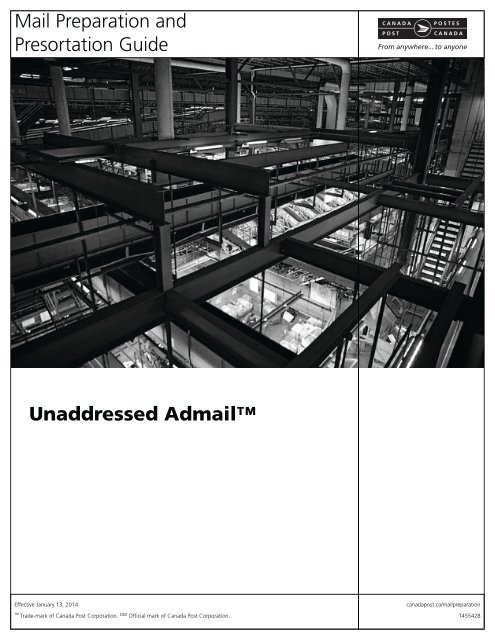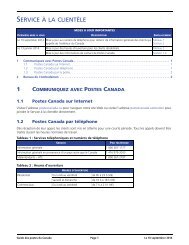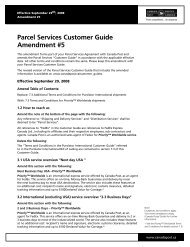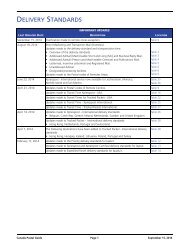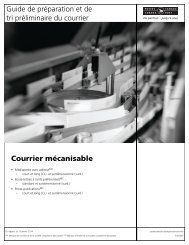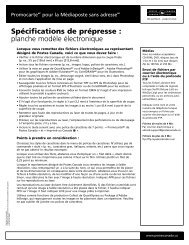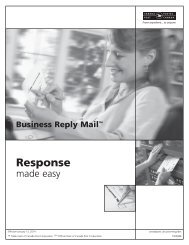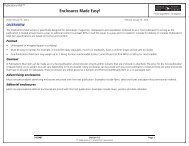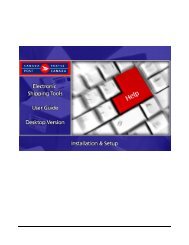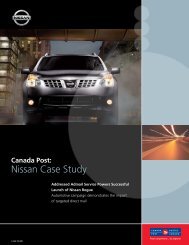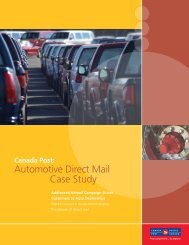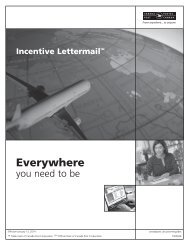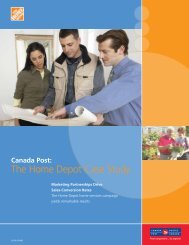Mail Preparation and Presortation Guide ... - Canada Post
Mail Preparation and Presortation Guide ... - Canada Post
Mail Preparation and Presortation Guide ... - Canada Post
Create successful ePaper yourself
Turn your PDF publications into a flip-book with our unique Google optimized e-Paper software.
<strong>Mail</strong> <strong>Preparation</strong> <strong>and</strong><br />
<strong>Presortation</strong> <strong>Guide</strong><br />
Unaddressed Admail<br />
Effective January 13, 2014<br />
Trade-mark of <strong>Canada</strong> <strong>Post</strong> Corporation. OM Official mark of <strong>Canada</strong> <strong>Post</strong> Corporation.<br />
canadapost.ca/mailpreparation<br />
T455428
<strong>Mail</strong> <strong>Preparation</strong> <strong>and</strong> <strong>Presortation</strong> <strong>Guide</strong> – Unaddressed Admail<br />
IMPORTANT UPDATES<br />
Any description of change is provided for reference <strong>and</strong> convenience purposes only. The<br />
description of change does not form part of the Agreement between the Customer <strong>and</strong> <strong>Canada</strong><br />
<strong>Post</strong>.<br />
Customers should ensure they are using the most current version of the <strong>Mail</strong> <strong>Preparation</strong> <strong>and</strong> <strong>Presortation</strong> <strong>Guide</strong>,<br />
including all amendments <strong>and</strong> other applicable documents, which are posted on the <strong>Canada</strong> <strong>Post</strong> website. See in<br />
particular, canadapost.ca/postalservices for key support documents.<br />
Important Updates:<br />
DESCRIPTION OF CHANGE<br />
LOCATION<br />
Revision v1.1 <strong>Post</strong>ed on April 16, 2014 Effective on April 16, 2014<br />
Updates made for bundling <strong>and</strong> strapping.<br />
Section 3.1.1 Bundling<br />
Section 3.1.2 Strapping<br />
Amendment v1.0 <strong>Post</strong>ed on November 15, 2013 Effective on January 13, 2014<br />
Removed refernce to <strong>Presortation</strong> software.<br />
Section 2.1 <strong>Post</strong>al Code<br />
Clarified all bundles must contain equal quantities except the last bundle.<br />
Section 3.1.1 Bundling<br />
Clarified that double strapping is required when not using single mechanically-applied Section 3.1.2 Strapping<br />
strapping.<br />
Removed reference to EST SOM Only tool being discontinued on January 13, 2014. Section 3.3 Complete the Unaddressed<br />
Admail Delivery Slip (ADS) (Step 3)<br />
Clarified that the Unaddressed Admail Delivery Slip (ADS) is only required when using a<br />
manual Order (Statement of <strong>Mail</strong>ing).<br />
Section 3.3 Complete the Unaddressed<br />
Admail Delivery Slip (ADS) (Step 3)<br />
Reminder of 2013 Updates:<br />
DESCRIPTION OF CHANGE<br />
LOCATION<br />
Revision v1.2 <strong>Post</strong>ed on July 22, 2013 Effective on July 22, 2013<br />
Updated bundle height from 100 mm to 152.4 mm (4 to 6 inches).<br />
Table 1: Unaddressed Admail key<br />
requirements<br />
Householder Counts now referred to as Urban <strong>and</strong> Rural Delivery Area Counts. Section 2.2 Urban <strong>and</strong> rural delivery area<br />
counts <strong>and</strong> maps<br />
Double-Strapping is no longer m<strong>and</strong>atory.<br />
Section 3.1.2 Strapping<br />
Revision v1.1 <strong>Post</strong>ed on December 14, 2012 Effective on January 14, 2013<br />
An Unaddressed Admail Delivery Slip (ADS) is not required when the Fully Featured (EST Section 3.3<br />
online or EST 2.0), Precision Targeter application <strong>and</strong> Express Order Entry versions are<br />
used.<br />
NOTE : This amendment updates the July 22, 2013 version 1.2 guide.<br />
When there is an amendment or a revision to the document, the version number will be modified as follows:<br />
• an amendment increases the first digit in the version (e.g., version 2.0, 3.0)<br />
• a revision increases the second digit in the version (e.g., version 1.1, 1.2)<br />
• the version number restarts at 1.0 every January of a given year.<br />
January 13, 2014 Version 1.1
TABLE OF CONTENTS<br />
Unaddressed Admail . . . . . . . . . . . . . . . . . . . . . . . . . . . . . . . . . . . . . . . . . . . . 1<br />
1 Overview. . . . . . . . . . . . . . . . . . . . . . . . . . . . . . . . . . . . . . . . . . . . . . . . . . . . . . . . . . . . . . . . . . . . . . . . . . . . . 1<br />
1.1 Who should use this <strong>Guide</strong>? . . . . . . . . . . . . . . . . . . . . . . . . . . . . . . . . . . . . . . . . . . . . . . . . . . . . . . . . . 1<br />
1.2 What is mail preparation for Unaddressed Admail?. . . . . . . . . . . . . . . . . . . . . . . . . . . . . . . . . . . . . . . . 1<br />
1.3 Key requirements . . . . . . . . . . . . . . . . . . . . . . . . . . . . . . . . . . . . . . . . . . . . . . . . . . . . . . . . . . . . . . . . . 1<br />
2 Before You Start . . . . . . . . . . . . . . . . . . . . . . . . . . . . . . . . . . . . . . . . . . . . . . . . . . . . . . . . . . . . . . . . . . . . . . . 2<br />
2.1 <strong>Post</strong>al Code . . . . . . . . . . . . . . . . . . . . . . . . . . . . . . . . . . . . . . . . . . . . . . . . . . . . . . . . . . . . . . . . . . . . . 2<br />
2.2 Urban <strong>and</strong> rural delivery area counts <strong>and</strong> maps. . . . . . . . . . . . . . . . . . . . . . . . . . . . . . . . . . . . . . . . . . . 3<br />
2.2.1 Urban <strong>and</strong> rural delivery area counts . . . . . . . . . . . . . . . . . . . . . . . . . . . . . . . . . . . . . . . . . . . . 3<br />
2.2.2 Urban <strong>and</strong> rural delivery area maps . . . . . . . . . . . . . . . . . . . . . . . . . . . . . . . . . . . . . . . . . . . . . 3<br />
2.2.2.1 FSA maps . . . . . . . . . . . . . . . . . . . . . . . . . . . . . . . . . . . . . . . . . . . . . . . . . . . . . . . 3<br />
2.2.2.2 Route maps . . . . . . . . . . . . . . . . . . . . . . . . . . . . . . . . . . . . . . . . . . . . . . . . . . . . . . 3<br />
2.3 National <strong>Presortation</strong> Schematic (Non-Lettermail) . . . . . . . . . . . . . . . . . . . . . . . . . . . . . . . . . . . . . . . . . 4<br />
2.4 Delivery modes . . . . . . . . . . . . . . . . . . . . . . . . . . . . . . . . . . . . . . . . . . . . . . . . . . . . . . . . . . . . . . . . . . . 5<br />
2.5 Electronic Shipping Tools (EST) . . . . . . . . . . . . . . . . . . . . . . . . . . . . . . . . . . . . . . . . . . . . . . . . . . . . . . . 5<br />
2.6 <strong>Mail</strong>ing <strong>and</strong> distribution plans. . . . . . . . . . . . . . . . . . . . . . . . . . . . . . . . . . . . . . . . . . . . . . . . . . . . . . . . 6<br />
3 Steps for Preparing Unaddressed Admail. . . . . . . . . . . . . . . . . . . . . . . . . . . . . . . . . . . . . . . . . . . . . . . . . . . 6<br />
3.1 Place the mail items in equivalent-sized bundles (Step 1). . . . . . . . . . . . . . . . . . . . . . . . . . . . . . . . . . . . 7<br />
3.1.1 Bundling . . . . . . . . . . . . . . . . . . . . . . . . . . . . . . . . . . . . . . . . . . . . . . . . . . . . . . . . . . . . . . . . . 7<br />
3.1.2 Strapping. . . . . . . . . . . . . . . . . . . . . . . . . . . . . . . . . . . . . . . . . . . . . . . . . . . . . . . . . . . . . . . . . 7<br />
3.2 Place the bundles in containers (Step 2) . . . . . . . . . . . . . . . . . . . . . . . . . . . . . . . . . . . . . . . . . . . . . . . . 7<br />
3.2.1 Types of containers . . . . . . . . . . . . . . . . . . . . . . . . . . . . . . . . . . . . . . . . . . . . . . . . . . . . . . . . . 8<br />
3.2.1.1 <strong>Canada</strong> <strong>Post</strong>-supplied hardsided containers . . . . . . . . . . . . . . . . . . . . . . . . . . . . . . 8<br />
3.2.1.2 Flexipack pouches . . . . . . . . . . . . . . . . . . . . . . . . . . . . . . . . . . . . . . . . . . . . . . . 9<br />
3.2.1.3 Customer-supplied containers . . . . . . . . . . . . . . . . . . . . . . . . . . . . . . . . . . . . . . . . 9<br />
3.3 Complete the Unaddressed Admail Delivery Slip (ADS) (Step 3) . . . . . . . . . . . . . . . . . . . . . . . . . . . . . . 10<br />
3.4 Label the containers (Step 4). . . . . . . . . . . . . . . . . . . . . . . . . . . . . . . . . . . . . . . . . . . . . . . . . . . . . . . . 10<br />
3.4.1 Label information requirements . . . . . . . . . . . . . . . . . . . . . . . . . . . . . . . . . . . . . . . . . . . . . . . 11<br />
3.4.2 Producing labels . . . . . . . . . . . . . . . . . . . . . . . . . . . . . . . . . . . . . . . . . . . . . . . . . . . . . . . . . . 11<br />
3.4.3 Special instructions for producing labels. . . . . . . . . . . . . . . . . . . . . . . . . . . . . . . . . . . . . . . . . 11<br />
3.4.4 Customer-generated label . . . . . . . . . . . . . . . . . . . . . . . . . . . . . . . . . . . . . . . . . . . . . . . . . . . 11<br />
3.4.5 Labelling hardsided containers . . . . . . . . . . . . . . . . . . . . . . . . . . . . . . . . . . . . . . . . . . . . . . . . 12<br />
3.4.6 Labelling customer-supplied containers . . . . . . . . . . . . . . . . . . . . . . . . . . . . . . . . . . . . . . . . . 12<br />
3.5 Make up <strong>and</strong> label monotainers <strong>and</strong> pallets (Step 5) . . . . . . . . . . . . . . . . . . . . . . . . . . . . . . . . . . . . . . 12<br />
3.5.1 Using the NPS to make up monotainers <strong>and</strong> pallets . . . . . . . . . . . . . . . . . . . . . . . . . . . . . . . . 15<br />
3.5.2 Labelling monotainers <strong>and</strong> pallets . . . . . . . . . . . . . . . . . . . . . . . . . . . . . . . . . . . . . . . . . . . . . 18<br />
4 Additional Resources . . . . . . . . . . . . . . . . . . . . . . . . . . . . . . . . . . . . . . . . . . . . . . . . . . . . . . . . . . . . . . . . . . 19<br />
<strong>Mail</strong> <strong>Preparation</strong> <strong>and</strong> <strong>Presortation</strong> <strong>Guide</strong> Version 1.1 Page i January 13, 2014
UNADDRESSED ADMAIL<br />
1 OVERVIEW<br />
1.1 Who should use this <strong>Guide</strong>?<br />
This guide explains how to prepare an Unaddressed Admail mailing for deposit to <strong>Canada</strong> <strong>Post</strong>.<br />
Please ensure you are using the most recent version of this guide <strong>and</strong> other support documents that detail our<br />
requirements, qualifications, terms <strong>and</strong> conditions, <strong>and</strong> pricing. These documents are available online at<br />
canadapost.ca/postalservices.<br />
It is your obligation to meet all the requirements outlined in your Customer Agreement.<br />
NOTE 1: Some words <strong>and</strong> expressions used in this document have a specific meaning. Please refer to Section 1<br />
Definitions of the General Terms <strong>and</strong> Conditions for the definition of specific terms referenced<br />
throughout this document <strong>and</strong> the Agreement.<br />
2: The figures throughout this document are examples for illustration purposes only.<br />
1.2 What is mail preparation for Unaddressed Admail?<br />
<strong>Mail</strong> preparation is the process of bundling mail items securely, placing them in <strong>Canada</strong> <strong>Post</strong> supplied hardsided<br />
containers, Flexipack pouches, or customer-supplied boxes pre-approved by <strong>Canada</strong> <strong>Post</strong>, <strong>and</strong> labelling the<br />
containers with the urban or rural delivery facility where the containers will be delivered.<br />
1.3 Key requirements<br />
To qualify as Unaddressed Admail:<br />
• the mail items must be mailed in <strong>Canada</strong> for delivery in <strong>Canada</strong><br />
• the mail items must meet all <strong>Canada</strong> <strong>Post</strong> requirements outlined in the Unaddressed Admail Agreement.<br />
Consult the Unaddressed Admail Customer <strong>Guide</strong> <strong>and</strong> other applicable documents outlined in the<br />
Unaddressed Admail Agreement (see Section 4 Additional Resources).<br />
Table 1: Unaddressed Admail key requirements<br />
Minimum volume per deposit* (see<br />
Section 2.5 Electronic Shipping Tools (EST)<br />
for more information)<br />
KEY REQUIREMENTS<br />
The minimum volume for distribution is:<br />
• the complete distribution of a given route; or<br />
• the complete distribution to only houses, apartments, farms, businesses, or any<br />
combination, on a given route.<br />
When mailing to more than one route:<br />
• less than full coverage of a given route is permitted, however these items will be<br />
delivered until depleted (in no particular order).<br />
It is the customer’s responsibility to provide the necessary quantities declared on the<br />
order <strong>and</strong> required for distribution. <strong>Canada</strong> <strong>Post</strong> will not be liable for shortages between<br />
volumes declared <strong>and</strong> volume inducted. Distribution information is available through the<br />
Householder Count Data. Visit canadapost.ca/uasupportdocuments.<br />
In some cases, a Letter Carrier route may cover more than one Forward Sortation Area<br />
(FSA). This is referred to as a “split walk”. Customers may choose which FSA within the<br />
split walk they wish to have covered by using the “Fully Featured” (EST Online or<br />
Electronic Shipping Tools 2.0) option, or by indicating the selected FSA on the<br />
Unaddressed Admail Delivery Slip when using a manual Order (Statement of <strong>Mail</strong>ing).<br />
<strong>Mail</strong> <strong>Preparation</strong> <strong>and</strong> <strong>Presortation</strong> <strong>Guide</strong> Version 1.1 Page 1 January 13, 2014
<strong>Mail</strong> <strong>Preparation</strong> <strong>and</strong> <strong>Presortation</strong> <strong>Guide</strong> – Unaddressed Admail<br />
Maximum items per bundle • 200 items <strong>and</strong> must not exceed 152.4 mm (6 inches) in bundle height (see<br />
Section 3.1.1 Bundling for additional information)<br />
• The mailing must be bundled in equal amounts except the last bundle for each<br />
Delivery Facility, which may be smaller (the Residue bundle).<br />
Maximum bundle height • 152.4 mm (6 inches) for mailings with items weighing less than 500 g<br />
• For delivery by Non-Letter Carrier Routes ONLY: 200 mm (8 inches) in bundle height<br />
for mailings with items weighing 500 g–1,000 g.<br />
Container requirements • Customer-supplied containers [including cardboard boxes not exceeding<br />
535 mm (length) x 251 mm (width) x 303 mm (depth)]<br />
• Lettertainers<br />
• Flats tubs (used for Oversize (O/S) Unaddressed Admail items only)<br />
• Small Flexipack pouches 241558**<br />
• Large Flexipack pouches 241559**<br />
• Brick-piled on customer-supplied pallets, <strong>Canada</strong> <strong>Post</strong> reusable plastic pallets or in<br />
monotainers; refer to the Brick-piling <strong>Mail</strong> <strong>Preparation</strong> <strong>and</strong> <strong>Presortation</strong> <strong>Guide</strong> at<br />
canadapost.ca/mailpreparation.<br />
Labelling <strong>Canada</strong> <strong>Post</strong> supplied<br />
hardsided containers <strong>and</strong><br />
customer-supplied containers<br />
(including boxes)<br />
Levels of consolidation for<br />
Monotainers/Pallets<br />
KEY REQUIREMENTS<br />
• Service type<br />
• Number of containers<br />
• Delivery facility<br />
• Delivery start date<br />
• NPS routing.<br />
• Urban Delivery Facility/Rural Delivery Facility – NPS Level 1<br />
• City – NPS Level 2<br />
• Distribution Centre Facility (DCF) – NPS Level 3<br />
• Forward Consolidation Point (FCP) – NPS Level 4.<br />
Label • <strong>Canada</strong> <strong>Post</strong>-produced: white with black ink<br />
• Customer-produced: white with black ink.<br />
* The most current Householder (Householder Counts) data available must be used.<br />
** Customers may use the new Unaddressed Admail Flexipack pouches for mailings deposited directly at a Delivery<br />
Installation <strong>and</strong> which do not require transportation, or for mailings consolidated at the Delivery Facility level 1 (NPS) which<br />
are inducted at a drop-off location.<br />
2 BEFORE YOU START<br />
This section explains basic information on <strong>Post</strong>al Codes OM , householder counts, maps, the National <strong>Presortation</strong><br />
Schematic (NPS), Delivery Modes, Electronic Shipping Tools (EST), <strong>and</strong> the mailing <strong>and</strong> distribution plans that are<br />
required to prepare Unaddressed Admail mailings.<br />
2.1 <strong>Post</strong>al Code<br />
The <strong>Post</strong>al Code is a six-character alphanumeric code in the form of ANA NAN, in which "A" represents a letter<br />
of the alphabet, <strong>and</strong> "N" represents a number. It is an integral part of every postal address in <strong>Canada</strong>, <strong>and</strong> was<br />
designed to help sort mail, both mechanically <strong>and</strong> manually.<br />
The <strong>Post</strong>al Code is made up of two segments, as shown in Figure 1:<br />
1. The first three characters (ANA) represent the Forward Sortation Area (FSA), a geographical region, <strong>and</strong><br />
2. The last three characters (NAN) represent the Local Delivery Unit (LDU), a specific city block or rural<br />
community.<br />
NOTE: Rural areas are identified by a zero in the FSA (e.g., M0L 3K2).<br />
January 13, 2014 Version 1.1 Page 2
<strong>Mail</strong> <strong>Preparation</strong> <strong>and</strong> <strong>Presortation</strong> <strong>Guide</strong> – Unaddressed Admail<br />
Figure 1: <strong>Post</strong>al code segments<br />
FSA<br />
LDU<br />
For more detailed information, please visit Section 5 of Addressing <strong>Guide</strong>lines in the <strong>Canada</strong> <strong>Post</strong>al <strong>Guide</strong>.<br />
2.2 Urban <strong>and</strong> rural delivery area counts <strong>and</strong> maps<br />
2.2.1 URBAN AND RURAL DELIVERY AREA COUNTS<br />
Information about the delivery areas served by <strong>Canada</strong> <strong>Post</strong>’s delivery offices is segmented into the number of<br />
houses, apartments, farms <strong>and</strong> business points of call that help customers determine the number of items<br />
needed for their mailing.<br />
The national database of Householder Counts is available on CD-ROM or by download from a secured <strong>Canada</strong><br />
<strong>Post</strong> FTP site on a 12-month subscription basis, which includes monthly updates. Visit canadapost.ca/data for<br />
Individual Householder Counts, which are available free of charge.<br />
For information on Data Products, visit the <strong>Canada</strong> <strong>Post</strong> Address Management web page at canadapost.ca/data<br />
or send an email to data.targetingsolutions@canadapost.ca or contact a <strong>Canada</strong> <strong>Post</strong> Representative at<br />
1-800-363-3459.<br />
2.2.2 URBAN AND RURAL DELIVERY AREA MAPS<br />
2.2.2.1 FSA maps<br />
The FSA Maps identify the specific geographic boundaries for every FSA in <strong>Canada</strong>. The maps will assist in<br />
determining sales territories, plan coverage for a direct mail campaign, or study new locations for a retail store or<br />
business. Visit canadapost.ca/cpc2/addrm/hh/default-e.asp to view the FSA Maps online.<br />
2.2.2.2 Route maps<br />
Urban <strong>and</strong> Rural Delivery Area Maps provide the actual routes (walks), covered by the Letter Carriers. This is<br />
particularly useful for targeting local neighbourhoods. Refer to Section 4.1.1.1 Electronic Shipping Tools (EST) of<br />
Unaddressed Admail – Customer <strong>Guide</strong> for more information. Visit canadapost.ca/cpc2/addrm/hh/defaulte.asp<br />
to view the Letter Carrier Walk Maps online.<br />
January 13, 2014 Version 1.1 Page 3
<strong>Mail</strong> <strong>Preparation</strong> <strong>and</strong> <strong>Presortation</strong> <strong>Guide</strong> – Unaddressed Admail<br />
Figure 2:<br />
2.3 National <strong>Presortation</strong> Schematic (Non-Lettermail)<br />
The National <strong>Presortation</strong> Schematic (NPS) has two schematics: for Lettermail <strong>and</strong> Non-Lettermail. For<br />
Unaddressed Admail, use the Non-Lettermail NPS.<br />
The Non-Lettermail National <strong>Presortation</strong> Schematic (NPS) is a set of tables that indicates how to consolidate mail<br />
through <strong>Canada</strong> <strong>Post</strong>’s mail distribution network, beginning with the FSA.<br />
The NPS is used as a consolidation tool for all <strong>Canada</strong> <strong>Post</strong> Communication products. The NPS has four levels of<br />
access:<br />
• Level 1 – Delivery Facility<br />
• Level 2 – City<br />
• Level 3 – Distribution Consolidation Facility (DCF), <strong>and</strong><br />
• Level 4 – Forward Consolidation Schematic (FCP).<br />
Following the NPS levels of access is key to the consolidation of Unaddressed Admail (as shown in Figure 3).<br />
January 13, 2014 Version 1.1 Page 4
<strong>Mail</strong> <strong>Preparation</strong> <strong>and</strong> <strong>Presortation</strong> <strong>Guide</strong> – Unaddressed Admail<br />
Figure 3: Illustration of the NPS<br />
FSA LEVEL 1<br />
DELIVERY FACILITY<br />
LEVEL 2<br />
CITY<br />
CONSOLIDATION<br />
LEVEL 3<br />
DISTRIBUTION<br />
CENTRE<br />
FACILITY<br />
(DCF)<br />
LEVEL 4<br />
FORWARD<br />
CONSOLIDATION<br />
POINT<br />
(FCP)<br />
K2S<br />
K0A<br />
K2S 1A0<br />
STITTSVILLE ON<br />
K0A 9Z0<br />
OTTAWA ON<br />
DCF<br />
K7K<br />
K7L<br />
K7M<br />
K7N<br />
K7P<br />
K7L 1X0<br />
KINGSTON ON<br />
STN MAIN<br />
K7M 5E0<br />
KINGSTON ON<br />
STN A<br />
K7L 1X0<br />
KINGSTON ON<br />
K0H 9Z0<br />
KINGSTON ON<br />
DCF<br />
K0A 9Z0<br />
OTTAWA ON<br />
FWD<br />
K0H<br />
K1P<br />
K1R<br />
K2P<br />
K1L<br />
K1M<br />
K1N<br />
K1G 2C0<br />
OTTAWA ON<br />
LCD CENTRETOWN<br />
K1L 5A0<br />
OTTAWA ON<br />
STN VANIER<br />
K1G 0A0<br />
OTTAWA ON<br />
NOTE: <strong>Canada</strong> <strong>Post</strong> updates the National <strong>Presortation</strong> Schematic (NPS) monthly. The NPS sample illustrations<br />
may not reflect the current NPS. To receive optimal service, customers must use the current version of<br />
the NPS.<br />
To avoid delays <strong>and</strong> extra h<strong>and</strong>ling charges, the current version of the National <strong>Presortation</strong> Schematic must be<br />
used. It is available at canadapost.ca/nps on the <strong>Canada</strong> <strong>Post</strong> website.<br />
2.4 Delivery modes<br />
A Delivery Mode refers to the methods of delivery. Examples of Delivery Modes are:<br />
• Letter Carrier Route (LC)<br />
• Call For (CF)<br />
• Direct (DIR)<br />
• General Delivery (GD)<br />
• Rural Route (RR)<br />
• Lock Boxes (PO Box)<br />
• Suburban Services (SS)<br />
• Motorized Route (MR).<br />
2.5 Electronic Shipping Tools (EST)<br />
Customers have the option of using either the EST Online version, Precision Targeter, or the EST 2.0 version of the<br />
Electronic Shipping Tools (EST). The EST 2.0 can be downloaded to the prepared Order (Statement of <strong>Mail</strong>ing).<br />
The EST software is free of charge <strong>and</strong> can be accessed through the Business segment of the <strong>Canada</strong> <strong>Post</strong><br />
website at canadapost.ca/newuser. Customers must register once in the Business segment of the website to<br />
access the EST. For technical enquiries, customers can call the Technical Help Line at<br />
1-866-511-0546.<br />
NOTE:<br />
Customers are required to provide a copy of the Order (Statement of <strong>Mail</strong>ing) to an authorized <strong>Canada</strong><br />
<strong>Post</strong> representative at deposit sites at the time of mailing or before transporting the items directly to a<br />
local deposit location. An Order (Statement of <strong>Mail</strong>ing) must be properly completed <strong>and</strong> transmitted<br />
prior to drop-off of the mailing. A copy of the Order (Statement of <strong>Mail</strong>ing) must accompany the first<br />
deposit of the mailing.<br />
January 13, 2014 Version 1.1 Page 5
<strong>Mail</strong> <strong>Preparation</strong> <strong>and</strong> <strong>Presortation</strong> <strong>Guide</strong> – Unaddressed Admail<br />
2.6 <strong>Mail</strong>ing <strong>and</strong> distribution plans<br />
Before preparing the mailing, a distribution plan is provided when EST is used, or a mailing plan [for manual<br />
Orders (Statements of <strong>Mail</strong>ing)]. These plans will guide the number of containers for each delivery facility <strong>and</strong> the<br />
labelling.<br />
When preparing Orders (Statement of <strong>Mail</strong>ings) using EST, a distribution plan will be generated, regardless of the<br />
number of destinations for the mailing.<br />
When preparing Orders (Statements of <strong>Mail</strong>ing) manually, a mailing plan must be prepared. Any format can be<br />
used as long as the following information is included:<br />
• Customer name<br />
• Customer account number<br />
• Order (Statement of <strong>Mail</strong>ing) serial number<br />
• control number(s) of each Unaddressed Admail Delivery Slip (ADS) in the mailing (there may be more than<br />
one Unaddressed ADS for a Delivery Facility, depending on the nature of the mailing, see Section 3.3<br />
Complete the Unaddressed Admail Delivery Slip (ADS) (Step 3) for more information)<br />
• <strong>Post</strong>al Code of the Delivery Facility listed on each Unaddressed ADS<br />
• volumes forwarded to each Delivery Facility.<br />
An Unaddressed Admail Delivery Slip (ADS) is only required when using a Manual Order (Statement of <strong>Mail</strong>ing)<br />
NOTE:<br />
Contract prices cannot be accessed using a manual Order (Statement of <strong>Mail</strong>ing). Manual Orders<br />
(Statements of <strong>Mail</strong>ing) containing Contract prices will be subject to applicable Non-Contract prices<br />
upon deposit. The applicable volume, however, will still count toward the annual volume commitment<br />
when mailings are deposited at a Receipt Verification Unit (RVU).<br />
3 STEPS FOR PREPARING UNADDRESSED ADMAIL<br />
<strong>Mail</strong> that has met all the requirements for Unaddressed Admail (see Section 1.3 Key requirements) goes through<br />
up to five steps for mail preparation:<br />
1. Place the mail items in equivalent-sized bundles (Step 1).<br />
2. Place the bundles in containers (Step 2).<br />
3. Complete the Unaddressed Admail Delivery Slip (ADS) (Step 3).<br />
4. Label the containers (Step 4) – Correct labelling ensures that mail is sent to the correct Delivery Facility.<br />
5. Make up <strong>and</strong> label monotainers <strong>and</strong> pallets (Step 5) – Monotainers <strong>and</strong> pallets make it much easier to<br />
move the mail because it reduces the amount of h<strong>and</strong>ling <strong>and</strong> ensures the complete mailing arrives<br />
simultaneously at any one destination.<br />
January 13, 2014 Version 1.1 Page 6
<strong>Mail</strong> <strong>Preparation</strong> <strong>and</strong> <strong>Presortation</strong> <strong>Guide</strong> – Unaddressed Admail<br />
3.1 Place the mail items in equivalent-sized bundles (Step 1)<br />
3.1.1 BUNDLING<br />
A “bundle” describes a number of mail items secured together. Unaddressed Admail items, including inserts <strong>and</strong><br />
samples, must be bundled securely to prevent breakage during h<strong>and</strong>ling or while in transit to the delivery facility<br />
responsible for delivery.<br />
Each Delivery Facility targeted by your mailing will receive at least one bundle. Use the distribution plan generated<br />
by <strong>Canada</strong> <strong>Post</strong> Electronic Shipping Tools (EST) or Precision Targeter as a reference.<br />
The mailing must be bundled in equal amounts. Each bundle is not to exceed the heights specified below. All<br />
bundles should contain equal quantities, except the last bundle of a mailing for each Delivery Facility which may<br />
be smaller <strong>and</strong> is referred to as the Residue bundle.<br />
The maximum height of a bundle will vary depending on the weight of the item as shown below. The maximum<br />
height takes precedence over the number of items.<br />
Table 2: Bundling specifications<br />
WEIGHT CATEGORIES<br />
Items weighing less than<br />
500 g (17.6 oz)<br />
Items weighing 500 g to<br />
1,000 g (17.6 - 35.3 oz)<br />
• Single strapping is acceptable when using elastic b<strong>and</strong>s for bundles that are placed in hardsided containers or<br />
customer supplied boxes. The elastic strip gauge must be a minimum of 0.5 cm wide <strong>and</strong> strong enough to<br />
prevent breakage during h<strong>and</strong>ling or while in transit. It is recommended, but not m<strong>and</strong>atory, to have the<br />
strapping applied to the shorter dimension of the bundle.<br />
3.1.2 STRAPPING<br />
Applicable to items delivered<br />
by Letter Carriers <strong>and</strong> Non-<br />
Letter Carriers.<br />
Applicable to items delivered<br />
by Non-Letter Carriers.<br />
MAX. HEIGHT OF EACH<br />
BUNDLE<br />
MAX. NUMBER OF ITEMS PER<br />
BUNDLE<br />
15.24 cm (6 in) 200 items<br />
20.0 cm (8 in) 200 items<br />
Each bundle must be secured to prevent breaking open during h<strong>and</strong>ling or while in transit. Single strapping is<br />
acceptable with St<strong>and</strong>ard <strong>and</strong> Oversize (O/S) items when using plastic strapping material or elastic b<strong>and</strong>s. Double<br />
strapping of bundles is recommended when using strings or manually-applied plastic straps.<br />
Figure 4: Examples of single-strapping <strong>and</strong> double-strapping<br />
3.2 Place the bundles in containers (Step 2)<br />
All items in a single mailing must be deposited in <strong>Canada</strong> <strong>Post</strong> supplied hardsided containers, Flexipack pouches,<br />
customer-supplied containers (including boxes) pre-approved by <strong>Canada</strong> <strong>Post</strong>, or brick-piled (please refer to the<br />
Brick-piling <strong>Mail</strong> <strong>Preparation</strong> <strong>and</strong> <strong>Presortation</strong> <strong>Guide</strong> at canadapost.ca/mailpreparation).<br />
Unaddressed Admail must be placed in one or more containers for each Delivery Facility.<br />
The weight of each container (the container plus the mailing) must not exceed 22.7 kg (50 lb).<br />
January 13, 2014 Version 1.1 Page 7
<strong>Mail</strong> <strong>Preparation</strong> <strong>and</strong> <strong>Presortation</strong> <strong>Guide</strong> – Unaddressed Admail<br />
3.2.1 TYPES OF CONTAINERS<br />
Three types of containers can be used for the movement of Unaddressed Admail through <strong>Canada</strong> <strong>Post</strong>’s mail<br />
distribution network:<br />
• <strong>Canada</strong> <strong>Post</strong> supplied hardsided containers (lettertainers <strong>and</strong> flats tubs)<br />
• Customer-supplied containers [including cardboard boxes not exceeding 535 mm (length) x 251 mm (width)<br />
x 303 mm (depth)]<br />
• Flexipack pouches<br />
The supply of <strong>Canada</strong> <strong>Post</strong> equipment is dependent on conditions <strong>and</strong> availability. In instances where <strong>Canada</strong><br />
<strong>Post</strong> equipment is not available, <strong>Canada</strong> <strong>Post</strong> pre-approved customer-supplied containers (e.g.: cardboard boxes)<br />
<strong>and</strong>/or pallets must be used.<br />
NOTE: Customers may access <strong>Canada</strong> <strong>Post</strong> equipment, when available, by contacting the National Equipment<br />
Container Facility (NECF) order desk by phone at 905-565-0480, by fax at 905-564-6830, by email at<br />
necf@canadapost.ca or through a Regional Equipment Coordinator. <strong>Canada</strong> <strong>Post</strong> equipment may only<br />
be used for mailings of <strong>Canada</strong> <strong>Post</strong> products, services or shipments. The equipment remains the<br />
exclusive property of <strong>Canada</strong> <strong>Post</strong> <strong>and</strong> is not permitted for personal use. The customer is responsible to<br />
ensure the equipment remains in good condition, reasonable wear <strong>and</strong> tear excepted.<br />
When targeting multiple delivery facilities in a mailing, customers may vary the type of containers used (hardsided<br />
containers, boxes, Flexipack pouches or brick-piled pallets), provided the same type of container is used for each<br />
delivery facility.<br />
3.2.1.1 <strong>Canada</strong> <strong>Post</strong>-supplied hardsided containers<br />
There are two types of hardsided containers: lettertainers <strong>and</strong> flats tubs.<br />
1. Lettertainers (as shown in Figure 5) may be used for St<strong>and</strong>ard <strong>and</strong> Oversize (O/S) Unaddressed Admail<br />
items.<br />
2. Flats tubs (as shown in Figure 6) must be used for Oversize (O/S) Unaddressed Admail items only.<br />
The maximum weight of a hardsided container (including the container <strong>and</strong> lid) <strong>and</strong> its contents cannot exceed<br />
22.7 kg (50 lb).<br />
All containers must be deposited with lids, except for containers prepared in a Level 1 (Delivery Facility or a Rural<br />
Delivery Facility) monotainer. These may be nested <strong>and</strong> deposited without lids. It is recommended that<br />
monotainers be covered with cardboard to protect the load, unless other local arrangements have been made<br />
with a <strong>Canada</strong> <strong>Post</strong> Representative.<br />
Figure 5: Lettertainer (may be used for St<strong>and</strong>ard <strong>and</strong> Oversize (O/S) Unaddressed Admail items)<br />
Figure 6: Flats tub (for Oversize (O/S) Unaddressed Admail items only)<br />
January 13, 2014 Version 1.1 Page 8
<strong>Mail</strong> <strong>Preparation</strong> <strong>and</strong> <strong>Presortation</strong> <strong>Guide</strong> – Unaddressed Admail<br />
Table 3 lists the specifications for hardsided containers.<br />
Table 3: Hardsided container specifications<br />
TYPE OF CONTAINER WEIGHT LENGTH WIDTH HEIGHT MAX WEIGHT<br />
(INCLUDING<br />
CONTAINER)<br />
Lettertainer 1.8 kg 535 mm (21.06 in) 251 mm (9.8 in) 156 mm (6.1 in) 22.7 kg (50 lb)<br />
Flats Tub 1.7 kg 405 mm (15.9 in) 240 mm (9.4 in) 303 mm (11.9 in) 22.7 kg (50 lb)<br />
Hardsided container fill requirements<br />
All containers are to be filled as much as possible, without exceeding 22.7 kg. There are no minimum fill<br />
requirements when hard-sided containers are used.<br />
To maximize the use of container fill, for uneven bundles, items can be placed width wise or length wise in the<br />
container. When preparing containers, ensure items do not exceed the maximum height.<br />
NOTE: The minimum fill requirement for hardsided containers nested without lids is 50% of the container's<br />
capacity.<br />
3.2.1.2 Flexipack pouches<br />
Two types of Flexipack pouches can be used for the movement of mail (as shown in Table 4):<br />
• small Flexipack pouches (241558)<br />
• large Flexipack pouches (241559).<br />
Table 4: Unaddressed Admail Flexipack pouch specifications<br />
TYPE WEIGHT LENGTH WIDTH MAX WEIGHT<br />
(INCLUDING POUCHES)<br />
Small Flexipack<br />
N/A 406 mm (16 in) 305 mm (12 in) 6 kg (13 lb)<br />
Pouches<br />
Large Flexipack<br />
Pouches<br />
N/A 610 mm (24 in) 483 mm (19 in) 11 kg (24 lb)<br />
3.2.1.3 Customer-supplied containers<br />
<strong>Canada</strong> <strong>Post</strong> must pre-approve the use of other containers. Such containers must, at minimum, meet the<br />
following guidelines:<br />
• are sturdy, i.e., able to withst<strong>and</strong> normal h<strong>and</strong>ling during processing (sorting with other containers,<br />
transporting, opening, emptying, etc.)<br />
• made from non-toxic <strong>and</strong> environmentally friendly materials<br />
• have a dimension of 535 mm (length) x 251 mm (width) x 303 mm (depth), to ensure the container can easily<br />
be h<strong>and</strong>led <strong>and</strong> transported by <strong>Canada</strong> <strong>Post</strong> equipment<br />
• have a maximum weight that does not exceed 22.7 kg (50 lb) for a box or a customer-supplied container<br />
• must be labelled to <strong>Canada</strong> <strong>Post</strong> requirements<br />
• are disposable (since they cannot be returned)<br />
• do not resemble containers that are commonly used for disposal or recycling (e.g., garbage bags,<br />
recycling bins)<br />
• have removed any other labels containing addressing information.<br />
January 13, 2014 Version 1.1 Page 9
<strong>Mail</strong> <strong>Preparation</strong> <strong>and</strong> <strong>Presortation</strong> <strong>Guide</strong> – Unaddressed Admail<br />
3.3 Complete the Unaddressed Admail Delivery Slip (ADS) (Step 3)<br />
An Unaddressed Admail Delivery Slip (ADS) is only required when using a manual Order (Statement of <strong>Mail</strong>ing) as<br />
the various Electronic Shipping Tools applications automatically generate labels that replace the ADS.<br />
The Unaddressed Admail Delivery Slip (ADS), (as shown in Figure 7), serves to identify the mailing <strong>and</strong> is attached<br />
to the Residue bundle for each Delivery Facility. It includes the specific delivery instructions, including the selected<br />
Forward Sortation Area (FSA) <strong>and</strong> route numbers.<br />
If the Order (Statement of <strong>Mail</strong>ing) is submitted manually (instead of using EST), the completed Unaddressed ADS<br />
for each Delivery Facility must be back stamped with the RVU stamp by the Receipt Verification Unit (RVU) or the<br />
office stamp by the Corporate Retail Counter or the Corporate Retail Counter barcoded label must be attached<br />
before the customer attaches Part 3 to the Residue Bundle. Part 3 of the Unaddressed ADS is proof of payment<br />
by the Delivery Facility.<br />
Figure 7: Unaddressed Admail Delivery Slip, Form #40-076-527<br />
Unaddressed Admail<br />
Delivery Slip<br />
Customer Identification<br />
Identification du client<br />
Customer Name Nom Customer/Acct No. du client N˚ du client/compte<br />
Feuille de dépôt<br />
Médiaposte sans adresse<br />
Delivery Instructions<br />
Delivery Office Address<br />
Upon receipt<br />
Sur réception or/ou<br />
Instructions de livraison<br />
Adresse du bureau de livraison<br />
Delivery Premier jour<br />
Start Date<br />
Year Année Month Mois Day Jour<br />
<strong>Mail</strong>ed by<br />
(Name <strong>and</strong> complete address)<br />
Expédié par<br />
(nom et adresse complète)<br />
Customer/Acct No.<br />
N˚ du client/compte<br />
FSA(s), Delivery Mode(s)<br />
<strong>and</strong> Number(s)<br />
RTA, mode(s) de<br />
livraison et numéro(s)<br />
All FSAs, Delivery Modes <strong>and</strong> Numbers<br />
Tous les RTA, modes de livraison et numéros<br />
Indicate specific FSA(s), Delivery Mode(s) <strong>and</strong> Number(s): Précisez les RTA, les modes de livraison et numéros :<br />
Title of mail piece<br />
Titre de l’article<br />
Version<br />
specific<br />
Version<br />
spécifique<br />
40-076-527 (07-09)<br />
Statement of<br />
<strong>Mail</strong>ing No.<br />
Weight per<br />
item (g)<br />
Number of<br />
containers<br />
N˚ de déclaration<br />
de dépôt<br />
Poids par<br />
article (g)<br />
Nombre de<br />
conteneurs<br />
Office of payment Bureau de paiement<br />
Coverage - Indicate if delivery required to: Couverture - Indiquez le mode de distribution :<br />
Houses<br />
Apartments<br />
Farms<br />
Businesses<br />
Domiciles<br />
Appartements<br />
Fermes<br />
Commerces<br />
Items per Articles par Number of Nombre des articles Size Selection<br />
Dimensions<br />
bundle<br />
liasse<br />
residue items résiduaires<br />
St<strong>and</strong>ard Up to<br />
Oversize 1 Up to<br />
Oversize 2 Up to<br />
30.5 X 15.24 cm (12” X 6”) 30.5 X 22.85 cm (12” X 9”) 35.56 X 28 cm (14” X 11”)<br />
Number of Nombre de Total Number Nombre total<br />
St<strong>and</strong>ard Jusqu’à<br />
Surdimensionné 1 Jusqu’à Surdimensionné 2 Jusqu’à<br />
bundles<br />
liasses<br />
of items des articles<br />
30,5 cm X 15,24 cm<br />
30,5 cm X 22,85 cm<br />
35,56 cm X 28 cm<br />
(12 po X 6 po)<br />
(12 po X 9 po)<br />
(14 po X 11 po)<br />
FOR CPC USE ONLY<br />
À L’USAGE DE LA SCP SEULEMENT<br />
Receipt - Office of Delivery Réception - Bureau de livraison<br />
Delivery completed Livraison complétée<br />
Signature<br />
Date<br />
Time Heure<br />
Signature<br />
Date<br />
0 000 000 000<br />
<strong>Mail</strong>er Copy Copie de l'expéditeur<br />
1<br />
There are three parts to the Unaddressed ADS:<br />
• Part 1: <strong>Mail</strong>er copy – The customer keeps the first page of the Unaddressed ADS for their files.<br />
• Part 2: Attach to the Statement of <strong>Mail</strong>ing – When the mailing is for 10 or fewer Delivery Facilities <strong>and</strong><br />
EST is not used, the second page of the Unaddressed ADS must be stapled to the back of the SOM (see<br />
Section 2.6 <strong>Mail</strong>ing <strong>and</strong> distribution plans for more information). If a Manifest is used, Part 2 of the<br />
Unaddressed ADS for the files may also be kept.<br />
• Part 3: Insert in the last container for each Delivery Facility – Attach the third page of the Unaddressed<br />
ADS to the Residue bundle, which is placed in the last container for each Delivery Facility. For example, if 40<br />
containers are being sent to a Delivery Facility, the Residue bundle can be inserted with the Unaddressed ADS<br />
attached in the container labelled as 40 of 40.<br />
3.4 Label the containers (Step 4)<br />
All containers must be labelled to their destination based on the Householder Counts available on CD-ROM or on<br />
the <strong>Canada</strong> <strong>Post</strong> website at canadapost.ca/cpc2/addrm/hh/default-e.asp or the NPS (Level 1 – Delivery Facility). If<br />
EST is used, container labels are generated automatically. Correct labelling of containers ensures that mail is<br />
directed to the correct Delivery Facility.<br />
When using <strong>Canada</strong> <strong>Post</strong> hardsided containers, labels must be placed in the label holder before depositing at a<br />
<strong>Canada</strong> <strong>Post</strong> facility.<br />
January 13, 2014 Version 1.1 Page 10
<strong>Mail</strong> <strong>Preparation</strong> <strong>and</strong> <strong>Presortation</strong> <strong>Guide</strong> – Unaddressed Admail<br />
3.4.1 LABEL INFORMATION REQUIREMENTS<br />
Container labels must be bilingual <strong>and</strong> include the service name (Unaddressed Admail). The label serves to<br />
identify the Delivery Facility; the mailing; <strong>and</strong> the service requirements. The following information is required:<br />
• <strong>Mail</strong>ed by: Indicate the name <strong>and</strong> mailing address of the company preparing the mailing for deposit with<br />
<strong>Canada</strong> <strong>Post</strong><br />
• <strong>Mail</strong>ed on behalf of: The name <strong>and</strong> mailing address of the company that owns the mail item<br />
• Delivery Facility: The name of the <strong>Canada</strong> <strong>Post</strong> Delivery Facility as defined in the <strong>Canada</strong> <strong>Post</strong> Householder<br />
counts information available on CD-ROM or on the <strong>Canada</strong> <strong>Post</strong> website at canadapost.ca/cpc2/addrm/hh/<br />
default-e.asp, or the NPS Level 1<br />
• Number of containers: Indicate the number of containers going to the same Delivery Facility in the format<br />
provided (e.g., 2 of 3 means that the container is the second of three containers for the Delivery Facility)<br />
• Delivery start date: Indicate the date that delivery is to begin.<br />
3.4.2 PRODUCING LABELS<br />
Depending on the customer’s preference, there are three options for producing labels. They can be:<br />
• generated automatically when using the “Fully Featured” (EST Online or Electronic Shipping Tools 2.0),<br />
Precision Targeter application <strong>and</strong> “Express Order Entry” version at the time of mailing<br />
• prepared manually using <strong>Canada</strong> <strong>Post</strong> supplied labels; or<br />
• created using <strong>Canada</strong> <strong>Post</strong> supplied blank labels.<br />
To order labels, contact the <strong>Canada</strong> <strong>Post</strong> Customer Relationship Network (1-888-550-6333 or 1-800-260-7678)<br />
<strong>and</strong> use the label form number to order labels. The label form numbers are listed in Table 5.<br />
Table 5: Unaddressed Admail, form numbers for labels<br />
DESCRIPTION FORM NUMBER ORDERING INFORMATION<br />
Peel-Off Label (supplied by<br />
<strong>Canada</strong> <strong>Post</strong>)<br />
Continuous Self-adhesive<br />
Label<br />
Self-adhesive labels can be affixed to customer-supplied containers such as boxes.<br />
NOTE: Large-volume mailers may choose between producing labels individually or in continuous strips (1 up,<br />
2 up, etc.) as best suited to the intended overprinting process.<br />
3.4.3 SPECIAL INSTRUCTIONS FOR PRODUCING LABELS<br />
Labels must fit (or be folded to fit) into label holders <strong>and</strong> be easily extracted from the label holders. For customersupplied<br />
containers, place labels in the same location on each container: on the top or the side of the container.<br />
3.4.4 CUSTOMER-GENERATED LABEL<br />
#33-086-523 (99-12) LVM/GEC (white stock with routing<br />
detail printed in black ink); #33-086-723 LVM/GEC (white<br />
stock with routing detail printed in black ink)<br />
#34-099-120 (00-07) LVM/GEC (white stock with black ink)<br />
Order from the <strong>Canada</strong> <strong>Post</strong><br />
Customer Relationship Network<br />
1-888-550-6333<br />
1-800-260-7678 or online at<br />
canadapost.ca/obc<br />
If using the Unaddressed Admail Peel Off Label (#33-086-523 [as shown in Figure 8] or #33-086-723 [as shown<br />
in Figure 9]), simply detach the tractor feed <strong>and</strong> insert the label into the label holder without removing the<br />
adhesive label from the protective backing (as shown in Figure 8).<br />
January 13, 2014 Version 1.1 Page 11
<strong>Mail</strong> <strong>Preparation</strong> <strong>and</strong> <strong>Presortation</strong> <strong>Guide</strong> – Unaddressed Admail<br />
Figure 8: Label #33-086-523<br />
Tractor Feed<br />
When using the Unaddressed Admail<br />
adhesive label (# 33-086-523), simply<br />
detach the tractor feed <strong>and</strong> insert the label<br />
into the label holder.<br />
Do not remove adhesive label from the<br />
protective backing.<br />
Self-adhesive labels such as label #33-086-723 (Figure 9) can be affixed to customer-supplied containers such as<br />
boxes.<br />
Figure 9: Label #33-086-723<br />
C8000001292<br />
0000000<br />
0000000 ABC COMPANY LTD<br />
123 MAIN ST<br />
HOMETOWN NF A1A 9Z9<br />
ABC COMPANY LTD<br />
3.4.5 LABELLING HARDSIDED CONTAINERS<br />
The Unaddressed Admail label must be completed (Form #33-086-523 or #33-086-723) <strong>and</strong> placed in the label<br />
holder for each container.<br />
3.4.6 LABELLING CUSTOMER-SUPPLIED CONTAINERS<br />
The Unaddressed Admail adhesive label must be completed (Form #33-086-523 or #33-086-723) <strong>and</strong> affixed to<br />
each container or Flexipack pouch. Place the label on the top or the side <strong>and</strong> in the same location of each<br />
container. For Flexipack pouches, affix the labels on the designated labelling area on each pouch.<br />
3.5 Make up <strong>and</strong> label monotainers <strong>and</strong> pallets (Step 5)<br />
Use of monotainers or pallets is optional for Unaddressed Admail, but <strong>Canada</strong> <strong>Post</strong> encourages the consolidation<br />
of customer-supplied containers (including boxes), Flexipack pouches, or <strong>Canada</strong> <strong>Post</strong> supplied hardsided<br />
containers by using monotainers or pallets. (Monotainers are preferable for consolidating Flexipack pouches).<br />
When pallets are used to consolidate Flexipack pouches, Gaylord-type packaging must be used to stabilize the<br />
pallets.<br />
A monotainer (as shown in Figure 10) is a large, collapsible, steel-frame container provided by <strong>Canada</strong> <strong>Post</strong>.<br />
During peak periods, such as Christmas, the number of monotainers requested may not be available.<br />
Monotainers <strong>and</strong> pallets maintain the integrity of the mail items that are placed on one Order (Statement of<br />
<strong>Mail</strong>ing) or intended for the same destination (e.g., all mail items for Vancouver arrive on one pallet). This reduces<br />
the amount of h<strong>and</strong>ling <strong>and</strong> helps ensure a complete mailing arrives at its destination at the same time.<br />
January 13, 2014 Version 1.1 Page 12
<strong>Mail</strong> <strong>Preparation</strong> <strong>and</strong> <strong>Presortation</strong> <strong>Guide</strong> – Unaddressed Admail<br />
A pallet (also referred to as a skid) is a wooden platform used for the conveyance of customer-supplied or <strong>Canada</strong><br />
<strong>Post</strong> supplied hardsided containers.<br />
<strong>Mail</strong>ers may use <strong>Canada</strong> <strong>Post</strong> reusable plastic pallets as a shipping unit for the following services (based on<br />
availability):<br />
• brick-piled Unaddressed Admail (refer to the Brick-piling <strong>Mail</strong> <strong>Preparation</strong> <strong>and</strong> <strong>Presortation</strong> <strong>Guide</strong> at<br />
canadapost.ca/mailpreparation)<br />
• containerized Unaddressed Admail.<br />
Reusable plastic pallets meet all of the above requirements <strong>and</strong> are available free of charge with a minimum order<br />
of 40 pallets. Reusable plastic pallets have economic, environmental <strong>and</strong> h<strong>and</strong>ling advantages over wooden<br />
pallets.<br />
NOTE 1: Customers may access <strong>Canada</strong> <strong>Post</strong> equipment, when available, by contacting the National Equipment<br />
Container Facility (NECF) order desk by phone at 905-565-0480, by fax at 905-564-6830, by email at<br />
necf@canadapost.ca or through a Regional Equipment Coordinator. <strong>Canada</strong> <strong>Post</strong> equipment may only<br />
be used for mailings of <strong>Canada</strong> <strong>Post</strong> products, services or shipments. The equipment remains the<br />
exclusive property of <strong>Canada</strong> <strong>Post</strong> <strong>and</strong> is not permitted for personal use. The customer is responsible to<br />
ensure the equipment remains in good condition, reasonable wear <strong>and</strong> tear excepted.<br />
2: To order reusable plastic pallets, customers must have an active <strong>Canada</strong> <strong>Post</strong> Agreement (for any<br />
service).<br />
Figure 10:<br />
Monotainer Wooden Block Pallet <strong>Canada</strong> <strong>Post</strong> Reusable Plastic Pallet<br />
Containers may be consolidated into monotainers or on pallets.<br />
NOTE: If mailing heavier items, the weight of the load determines what is a complete pallet or monotainer: the<br />
items, container <strong>and</strong> shipping unit combined cannot weigh more than 900 kg.<br />
January 13, 2014 Version 1.1 Page 13
<strong>Mail</strong> <strong>Preparation</strong> <strong>and</strong> <strong>Presortation</strong> <strong>Guide</strong> – Unaddressed Admail<br />
Table 6: Monotainer <strong>and</strong> Pallet Specifications<br />
SPECIFICATION PALLET MONOTAINER<br />
Length<br />
1.22 m<br />
(48”)<br />
1.322 m<br />
(52”)<br />
Width<br />
1.02 m<br />
(40”)<br />
1.067 m<br />
(42”)<br />
Load requirements (including mail <strong>and</strong> shipping unit)<br />
Maximum height <strong>and</strong> weight • height: 1.5 m (59”) including the height of the pallet - • height: 1.115 m (43.8”)<br />
base <strong>and</strong> cap<br />
• Contents may be stacked up to<br />
• weight: 900 kg (<strong>Canada</strong> <strong>Post</strong> reusable plastic pallet<br />
weighs 9 kg)<br />
25 mm below the top of the<br />
monotainer.<br />
• weight 900 kg (monotainer<br />
weighs 97 kg)<br />
Minimum height <strong>and</strong> weight • mail must be at least 500 mm (excluding height of the<br />
pallet) for 18 lettertainers or 12 flats tubs for mail<br />
destined within the province of deposit <strong>and</strong> 75% of<br />
the height (27 lettertainers or 18 flats tubs) for mail<br />
destined outside the province of deposit<br />
for brick-piled mailings, refer to the Brick-piling<br />
<strong>Mail</strong> <strong>Preparation</strong> <strong>and</strong> <strong>Presortation</strong> <strong>Guide</strong> at<br />
canadapost.ca/mailpreparation<br />
Other requirements • pallets are securely fastened <strong>and</strong> structurally sound<br />
• stretch-wrapping required three times around the<br />
pallet as well as the pallet load<br />
• if using wooden pallets, it is recommended that the<br />
block design be used (see diagram in Figure 10)<br />
• pallets must not have critical defects, i.e. exposed<br />
nails, significant splits, missing wood, decay <strong>and</strong><br />
damaged/ jagged members<br />
• top surface of the pallet must be flat <strong>and</strong> stable to<br />
enable the mail to be safely loaded/unloaded without<br />
tipping or sliding<br />
• pallets must withst<strong>and</strong> temperatures of -40°C to 40°C<br />
<strong>and</strong> severe weather conditions such as rain, snow, ice<br />
<strong>and</strong> humidity<br />
• should allow four-way entry by a <strong>Canada</strong> <strong>Post</strong> forklift<br />
<strong>and</strong> two-way entry by a <strong>Canada</strong> <strong>Post</strong> h<strong>and</strong> jack (to<br />
h<strong>and</strong>le pallet with no bottom deck board obstruction)<br />
• openings for forks shall be: a min. of 102 mm (4”)<br />
high on opposite sides of the pallet that do not have<br />
bottom deck boards; <strong>and</strong> a minimum of 89 mm (3.5”)<br />
for opposite sides that have bottom deck boards<br />
• metal strapping is not permitted<br />
• pallets shall conform to:<br />
ASTM - D1185 - St<strong>and</strong>ard Test Methods for Pallets<br />
<strong>and</strong> related Structures Employed in Materials<br />
H<strong>and</strong>ling <strong>and</strong> Shipping<br />
ISO-8611 - Pallets for Materials H<strong>and</strong>ling - Flat<br />
Pallets- Part 3: Maximum working Loads<br />
Uniform St<strong>and</strong>ard for Wood Pallets by National<br />
Wooden Pallet & Container Association (U.S.A.).<br />
Critical dimensions of <strong>Canada</strong><br />
<strong>Post</strong> Corporation MHE equipment<br />
used for h<strong>and</strong>ling pallets<br />
• distance across forks: max. 686 mm (27”)<br />
• distance between forks: min. 204 mm (8”)<br />
• height of the lowered fork: max. 89 mm (3.5”)<br />
• mail must fill at least 50% of<br />
the height of the monotainer<br />
(18 lettertainers or 12 flats<br />
tubs) for mail destined within<br />
the province of deposit <strong>and</strong><br />
75% of the height (27<br />
lettertainers or 18 flats tubs) for<br />
mail destined outside the<br />
province of deposit<br />
January 13, 2014 Version 1.1 Page 14
<strong>Mail</strong> <strong>Preparation</strong> <strong>and</strong> <strong>Presortation</strong> <strong>Guide</strong> – Unaddressed Admail<br />
3.5.1 USING THE NPS TO MAKE UP MONOTAINERS AND PALLETS<br />
If consolidation of customer-supplied containers, <strong>Canada</strong> <strong>Post</strong> supplied hardsided containers or Flexipack pouches<br />
using pallets or monotainers is chosen, the following illustrations show how to use the NPS for container<br />
consolidation.<br />
Containers may be consolidated into monotainers or onto pallets for all four levels of the NPS (as shown in<br />
Figure 11). Flexipack pouches may be consolidated into monotainers or onto pallets for level 1 of the NPS as<br />
shown in Table 7.<br />
NOTE: Customers may deposit mailings that include a portion for local delivery <strong>and</strong> the remaining portion<br />
requiring transportation; however they must be prepared in separate container(s), monotainer(s), or<br />
pallet(s), when applicable.<br />
Table 7: Acceptable consolidation levels for Flexipack pouches<br />
An entire Unaddressed<br />
Admail mailing destined<br />
to an urban or rural area<br />
(Level 1 NPS) - including<br />
transportation <strong>and</strong> direct<br />
deposits.<br />
DIRECT DEPOSIT<br />
(TRANSPORTATION<br />
NOT REQUIRED)<br />
LEVEL 1<br />
DELIVERY<br />
FACILITY<br />
(NPS)<br />
LEVEL 2<br />
URBAN<br />
(NPS)<br />
LEVEL 3 DCF<br />
(NPS)<br />
LEVEL 4 FCP<br />
(NPS)<br />
Yes Yes No Yes* Yes*<br />
Yes Yes Yes* Yes* Yes*<br />
Yes Yes Yes* Yes* Yes*<br />
* Acceptable when targeting rural delivery installations. Visit canadapost.ca/uasupportdocuments for a list of rural FSA.<br />
Nesting of hardsided containers without lids<br />
Customers preparing mailings in hardsided containers for a direct Urban Delivery Facility or a Rural Delivery<br />
Facility (both Level 1) monotainer may nest hardsided containers without lids. It is recommended that full<br />
monotainers be covered with cardboard to protect the load. When using pallets (<strong>Canada</strong> <strong>Post</strong> reusable plastic<br />
pallets or wooden pallets), lids must be used <strong>and</strong> nesting of hardsided containers is not acceptable.<br />
Figure 11: NPS levels<br />
LEVEL 1<br />
URBAN<br />
DELIVERY<br />
FACILITY/<br />
RURAL<br />
DELIVERY<br />
FACILITY<br />
LEVEL 2<br />
CITY<br />
LEVEL 3<br />
DCF<br />
LEVEL 4<br />
FCP<br />
January 13, 2014 Version 1.1 Page 15
<strong>Mail</strong> <strong>Preparation</strong> <strong>and</strong> <strong>Presortation</strong> <strong>Guide</strong> – Unaddressed Admail<br />
Customers that have sufficient hardsided containers or customer-supplied containers to fill a monotainer or pallet<br />
can make an Urban Delivery Facility or a Rural Delivery Facility (both Level 1) monotainer or pallet. Customers can<br />
also consolidate direct Urban or rural delivery facility containers using the National <strong>Presortation</strong> Schematic (NPS)<br />
to levels 1-4. <strong>Mail</strong>ings may also be containerized using Unaddressed Admail Flexipack pouches, when they are<br />
deposited directly at a Delivery Installation <strong>and</strong> do not require transportation or when consolidated at the Delivery<br />
Facility Level 1 (NPS) <strong>and</strong> inducted at a RVU or a Retail Outlet. Figure 12 shows the label that would be produced<br />
when there are enough containers to fill a monotainer or pallet for K1P, K1R <strong>and</strong> K2P (see Section 3.5.2 Labelling<br />
monotainers <strong>and</strong> pallets for more information).<br />
Figure 12: Sample illustration of the NPS<br />
FSA LEVEL 1<br />
DELIVERY FACILITY<br />
LEVEL 2<br />
CITY<br />
CONSOLIDATION<br />
LEVEL 3<br />
DISTRIBUTION<br />
CENTRE<br />
FACILITY<br />
(DCF)<br />
LEVEL 4<br />
FORWARD<br />
CONSOLIDATION<br />
POINT<br />
(FCP)<br />
K2S<br />
K0A<br />
K1P<br />
K1R<br />
K2P<br />
K1L<br />
K1M<br />
K1N<br />
K2S 1A0<br />
STITTSVILLE ON<br />
K1G 2C0<br />
OTTAWA ON<br />
LCD CENTRETOWN<br />
K1L 5A0<br />
OTTAWA ON<br />
STN VANIER<br />
K1G 0A0<br />
OTTAWA ON<br />
K0A 9Z0<br />
OTTAWA ON<br />
DCF<br />
K0A 9Z0<br />
OTTAWA ON<br />
FWD<br />
UNADDRESSED ADMAIL<br />
K1G 2C0<br />
OTTAWA ON<br />
LCD CENTRETOWN<br />
NPS Routing<br />
Information<br />
If there are not enough containers to make an Urban Delivery Facility or a Rural Delivery Facility (both NPS Level 1)<br />
monotainer or pallet, the next option is to consolidate containers for more than one Urban Delivery Facility (as<br />
indicated by brackets of inclusion on the NPS) to make a City Consolidation (Level 2) monotainer or pallet. For<br />
example, consolidate containers for K1P, K1R <strong>and</strong> K2P with containers for K1L, K1M <strong>and</strong> K1N (as shown in<br />
Figure 13).<br />
Figure 13:<br />
FSA LEVEL 1<br />
DELIVERY FACILITY<br />
LEVEL 2<br />
CITY<br />
CONSOLIDATION<br />
LEVEL 3<br />
DISTRIBUTION<br />
CENTRE<br />
FACILITY<br />
(DCF)<br />
LEVEL 4<br />
FORWARD<br />
CONSOLIDATION<br />
POINT<br />
(FCP)<br />
K2S<br />
K0A<br />
K1P<br />
K1R<br />
K2P<br />
K1L<br />
K1M<br />
K1N<br />
K2S 1A0<br />
STITTSVILLE ON<br />
K1G 2C0<br />
OTTAWA ON<br />
LCD CENTRETOWN<br />
K1L 5A0<br />
OTTAWA ON<br />
STN VANIER<br />
K1G 0A0<br />
OTTAWA ON<br />
K0A 9Z0<br />
OTTAWA ON<br />
DCF<br />
K0A 9Z0<br />
OTTAWA ON<br />
FWD<br />
UNADDRESSED ADMAIL<br />
NPS Routing<br />
Information<br />
K1G 0A0<br />
OTTAWA ON<br />
January 13, 2014 Version 1.1 Page 16
<strong>Mail</strong> <strong>Preparation</strong> <strong>and</strong> <strong>Presortation</strong> <strong>Guide</strong> – Unaddressed Admail<br />
If there are not enough containers to meet the minimum fill requirement of a monotainer or pallet, for City<br />
Consolidation, determine whether DCF Consolidation is permitted for the next level. If it is permitted in the NPS<br />
Routing Information, consolidate containers with other Urban <strong>and</strong>/or Rural Delivery Facilities (as indicated by<br />
brackets of inclusion on the NPS), to make a DCF (Level 3) monotainer or pallet. For example, consolidate<br />
containers for K7K <strong>and</strong> K7L with those for K0H (as shown in Figure 14).<br />
Figure 14:<br />
FSA LEVEL 1<br />
DELIVERY FACILITY<br />
LEVEL 2<br />
CITY<br />
CONSOLIDATION<br />
LEVEL 3<br />
DISTRIBUTION<br />
CENTRE<br />
FACILITY<br />
(DCF)<br />
LEVEL 4<br />
FORWARD<br />
CONSOLIDATION<br />
POINT<br />
(FCP)<br />
K2S<br />
K0A<br />
K2S 1A0<br />
STITTSVILLE ON<br />
K0A 9Z0<br />
OTTAWA ON<br />
DCF<br />
K7K<br />
K7L<br />
K7M<br />
K7N<br />
K7P<br />
K7L 1X0<br />
KINGSTON ON<br />
STN MAIN<br />
K7M 5E0<br />
KINGSTON ON<br />
STN A<br />
K7L 1X0<br />
KINGSTON ON<br />
K0H 9Z0<br />
KINGSTON ON<br />
DCF<br />
K0A 9Z0<br />
OTTAWA ON<br />
FWD<br />
K0H<br />
K1P<br />
K1R<br />
K2P<br />
K1L<br />
K1M<br />
K1N<br />
K1G 2C0<br />
OTTAWA ON<br />
LCD CENTRETOWN<br />
K1L 5A0<br />
OTTAWA ON<br />
STN VANIER<br />
K1G 0A0<br />
OTTAWA ON<br />
UNADDRESSED ADMAIL<br />
K0H 9Z0<br />
KINGSTON ON<br />
DCF<br />
NPS Routing<br />
Information<br />
If DCF consolidation is not permitted or if there are not enough containers for DCF consolidation, consolidate<br />
containers with other Urban <strong>and</strong>/or Rural Delivery Facilities (as indicated by brackets of inclusion on the NPS), to<br />
make an FCP (Level 4) monotainer or pallet. For example, consolidate all of the above with containers for K2S <strong>and</strong><br />
K0A (as shown in Figure 15).<br />
Figure 15:<br />
FSA LEVEL 1<br />
DELIVERY FACILITY<br />
LEVEL 2<br />
CITY<br />
CONSOLIDATION<br />
LEVEL 3<br />
DISTRIBUTION<br />
CENTRE<br />
FACILITY<br />
(DCF)<br />
LEVEL 4<br />
FORWARD<br />
CONSOLIDATION<br />
POINT<br />
(FCP)<br />
K2S<br />
K0A<br />
K2S 1A0<br />
STITTSVILLE ON<br />
K0A 9Z0<br />
OTTAWA ON<br />
DCF<br />
K7K<br />
K7L<br />
K7M<br />
K7N<br />
K7P<br />
K7L 1X0<br />
KINGSTON ON<br />
STN MAIN<br />
K7M 5E0<br />
KINGSTON ON<br />
STN A<br />
K7L 1X0<br />
KINGSTON ON<br />
K0H 9Z0<br />
KINGSTON ON<br />
DCF<br />
K0A 9Z0<br />
OTTAWA ON<br />
FWD<br />
K0H<br />
K1P<br />
K1R<br />
K2P<br />
K1L<br />
K1M<br />
K1N<br />
K1G 2C0<br />
OTTAWA ON<br />
LCD CENTRETOWN<br />
K1L 5A0<br />
OTTAWA ON<br />
STN VANIER<br />
K1G 0A0<br />
OTTAWA ON<br />
UNADDRESSED ADMAIL<br />
K0A 9Z0<br />
OTTAWA ON FWD<br />
NPS Routing<br />
Information<br />
January 13, 2014 Version 1.1 Page 17
<strong>Mail</strong> <strong>Preparation</strong> <strong>and</strong> <strong>Presortation</strong> <strong>Guide</strong> – Unaddressed Admail<br />
3.5.2 LABELLING MONOTAINERS AND PALLETS<br />
Labelling monotainers <strong>and</strong> pallets ensures that mail is directed to the appropriate work centre within a <strong>Canada</strong><br />
<strong>Post</strong> facility. All pallets <strong>and</strong> monotainers must be labelled.<br />
Each label must measure 216 mm x 279 mm (8.5 in x 11 in), have white with black lettering <strong>and</strong> must include the<br />
following information (as shown in Figure 16):<br />
• Service name (Unaddressed Admail)<br />
• NPS routing information, as follows:<br />
facility <strong>Post</strong>al Code (e.g. K0A 9Z0)<br />
facility name (e.g., OTTAWA)<br />
province abbreviation (e.g., ON), <strong>and</strong><br />
routing designation (e.g., DCF).<br />
Figure 16 shows what information should be on a label for a monotainer or pallet.<br />
Figure 16:<br />
216 mm<br />
(8.5")<br />
length<br />
UNADDRESSED ADMAIL<br />
279 mm<br />
(11")<br />
width<br />
Reserved for<br />
Customer Information<br />
K0A 9Z0<br />
OTTAWA ON DCF<br />
Service<br />
Name<br />
Facility <strong>Post</strong>al<br />
Code<br />
Facility Name<br />
Routing<br />
Designation<br />
Province<br />
Abbreviation<br />
Choose a font size large enough to use the entire label. The destination plant must be visibly larger than other<br />
information, including customer information.<br />
Each monotainer must have at least one label [two are recommended] <strong>and</strong> each pallet must have two labels (see<br />
Figure 17).<br />
Figure 17: Labels attached to monotainers <strong>and</strong> pallets<br />
Label(s)<br />
Labels<br />
Monotainer<br />
Stretch-wrapped Pallet<br />
January 13, 2014 Version 1.1 Page 18
<strong>Mail</strong> <strong>Preparation</strong> <strong>and</strong> <strong>Presortation</strong> <strong>Guide</strong> – Unaddressed Admail<br />
4 ADDITIONAL RESOURCES<br />
For more information on service qualifications <strong>and</strong> requirements for <strong>Canada</strong> <strong>Post</strong>’s services, please refer to:<br />
• Unaddressed Admail Customer <strong>Guide</strong><br />
For information <strong>and</strong> tools designed to assist you in preparing mailings for deposit to approved <strong>Canada</strong> <strong>Post</strong><br />
facilities, please refer to:<br />
• FSA <strong>and</strong> Urban <strong>and</strong> Rural Delivery Area Maps<br />
• Data & Targeting Solutions<br />
• Urban <strong>and</strong> Rural Delivery Area Counts<br />
• Electronic Shipping Tools (EST)<br />
• Container label artwork.<br />
January 13, 2014 Version 1.1 Page 19


